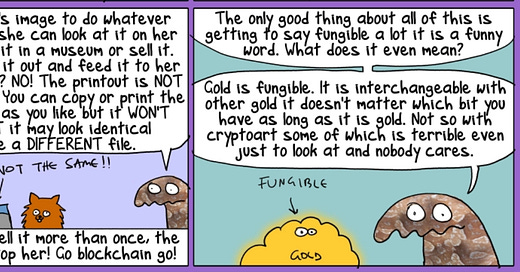Welcome to Just Two Things, which I try to publish daily, five days a week. Some links may also appear on my blog from time to time. Links to the main articles are in cross-heads as well as the story.
#1: The hole at the heart of NFTs
The tech newsletters I follow have been over-excited about NFTs, or “non-fungible tokens” for a while now, probably because it allows them to write about cool digital artists rather than decidedly uncool Silicon Valley bros. Me, I’ve been struggling with it a bit. Fortunately Alex Hern’s newsletter came to my rescue. Just in time, since a piece of digital art has just sold at Christies for almost $70 million.
(The best rapid explainer is by the Australian cartoonist First Dog on the Moon, from which the image is taken.)
So let’s unpack the language first. The language about tokens comes from the world of crypto-currency. In terms of value, a fungible token has the same property as money, hence “fungibility”. If I swap a fungible token with you for one of the same value, nothing’s changed. We both still have the same store of value.
A non-fungible token, however, is unique. If I swap my non-fungible token with yours, we end up with something different. The first is not substitutable for the second. I’ve given you my Hockney print and have ended up with a Paul Nash. The reason that NFTs are all the rage is that by identifying the artist they allow the value in digital art-works to be identified and retained—including a cut for the artist when the work is sold on. Like the fungible tokens, though, the record of ownership sits in the blockchain.
In his article Alex Hern notes that the principle that sits behind this has been around for a few years now. There are some first generation NFTs that operate pretty much like trading cards. But:
the interest in the field has also expanded to protocols, including Zora and SuperRare, which aim to provide a more general service for creating and trading any digital asset imaginable. These are, for the most part, what people have been discussing in the last week or so: services which let you take, well, anything digital – a song file, image, poem – "mint" it as a new token, and then sell and trade it using, generally, the Ethereum blockchain.
All the same, the impulse behind this probably isn’t a vast cultural rush in the population but more likely loose money and loose time chasing a shortage of assets.
The Christies’ artist Beeple, aka Mike Winkelmann, told Elizabeth Howcroft at Reuters:
“Without the NFTs, there just legitimately was no way to collect digital art,” said Beeple, who makes irreverent digital art on themes such as technology, wealth and American politics… For NFTs, the artist’s royalties are locked in to the contract: Beeple receives 10% each time the NFT changes hands after the initial sale.
Hern suggests that this is a fairly narrow use case, since copyright is not contested in law, and is vested automatically in a work that is created, even in the United States. But we’re not talking trivial sums of money: the all time sales volume of NFTs is $415 million, and art—at least before last week—represnted a quarter of that. And cryptocurrency lawyer Max Dilendorf told Reuters that he expected the whole art market to be digitised within five years.
Put like that, it perhaps seems like an answer to a different problem; the way that digital platforms (think of Spotify) have squeezed the creators out of the value chain in cultural markets. This might be what the work of art looks like in the age of digital reproduction. Musicians such as Jacques Greene and Devendra Banhart are experimenting with NFTs that combine art and music, creating new value for music collectors.
However, the elephant in the room for NFTs is their environmental footprint, which is vast. Hern summed it up like this:
No matter what you think the potential of the sector, it is inarguable that the current energy drain is out of whack with the current economic benefits. We're talking "burn a lifetime's worth of electricity to sell a digital edition of 1000 artworks"…
The French sculptor and climate activist Joanie Lemercier sold six NFTs in his first blockchain drop, and then discovered that his sale consumed 8.7 megawatt-hours of energy — equivalent to two years of energy use in his studio. Beeple has been working to offset the emissions from his NFTs, although offsetting has sceptics. Ethereum, the dominant platform, may be more energy intensive than alternatives. But this is certainly a live issue for many artists.
As Memo Akten told Flash Art:
Digital artists absolutely should be able to earn a living making the work they love. But this should not involve the immense footprint it does presently nor the current lack of transparency. New businesses and platforms must align with the values we are hoping to carry into the future.
#2: Cracking the Royal carapace
Just Two Things doesn’t do hot takes, and it tries to stay away from local difficulties. But there’s something about the reverberating aftermath of Oprah’s interview with Harry and Meghan that seems to have channelled into some of Britain’s faultlines. I’m not that interested in the interview itself—as far as that’s concerned, I got all the coverage I needed from the Daily Mash.
But I have become mildly obsessed with this clip of Good Morning Britain, partly because of its car crash quality:


I worked in news and talk broadcasting for about a decade at the start of my career, while also immersing myself in the sociological literature around newsrooms and how they work. One of the best accounts, about the workings of BBC News, was called Putting Reality Together. Its main thrust was about how hard the codes of newswriting, reporting and presentation worked to construct the notion of normal.
One of the observations that’s sometimes made about daily news programmes like Good Morning Britain is that part of their ‘normality’ is that they often present themselves as a second marriage: older, patriarchal male, younger woman. This means that they can absorb quite a lot of controversy about gender, even if they are unfailingly conservative about it, but seem unable to manage controversies about race.
It’s not coincidence, I think, that Alex Beresford, whose criticism caused Morgan to flounce out, is mixed race. Just as it wasn’t coincidence that presenter Naga Muchetty ended up on the wrong side of the BBC complaints system after her sofa conversation with Dan Walker about Donald Trump’s racism, whereas Walker did not.
And as David Allen Green observed in a sharp edition of his newsletter, the media and the royal family run through each other like a stick of rock, for a reason that goes to the heart of the royal family’s relationship with the state of which they are the constitutional heads:
[T]he one thing that the monarchy really cannot do – by definition – is expressly seek the consent of the governed. And so, not being able to obtain our consent, it seeks our approval. But the approval – or apparent approval – of the people cannot be easily sought or obtained other than through the structures of the established media… That the monarchy constantly needs such approval is not a bug of our constitutional arrangements, but a core feature.”
Of course, if you really want to understand what’s happening in Britain, you need to read the Irish media. There’s something about being the bullied neighbour for most of 700 years that provides more clarity. And in The Irish Times, Patrick Freyne obliges in his review of the interview:
Over the course of the interview Harry and Meghan, who are charming, clever and good at being celebrities, make the monarchy look like an archaic and endemically racist institution that has no place in the modern world. Well duh… [T]hey also did something else that renders everything else irrelevant: they officially launched themselves in the United States… Despite the tabloid frenzy, this was never the story of an ungrateful pauper being elevated by the monarchy. This was about the potential union of two great houses, the Windsors and Californian Celebrity.
Update: Octavia Butler reaches Mars. I wrote about Octavia Butler a couple of weeks ago. NASA’s Perseverance rover has just named its landing site after the author.
j2t#056
If you are enjoying Just Two Things, please do send it on to a friend or colleague.



